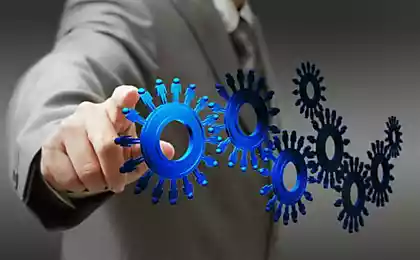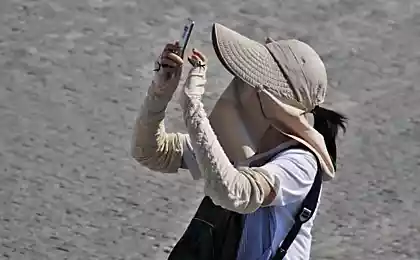608
Selfie: a new trick of perception, or in search of lost identity
We all have friends who love taking pictures of themselves always and everywhere: in cafes, on walks, at Breakfast and even (a classic!) in front of a mirror in a public restroom. Often meeting with them turns into an endless and pointless photo shoot.
Today about a selfie and dependence on him, called "selfism" had many jokes, and not very funny stories. In addition, this phenomenon has become the subject of various psychological studies. Let's try to understand what is self, what is its role in contemporary culture, and how and why it formed a dependence on him.
Eighty one million six hundred seventy thousand one hundred eighty four
Social networks and reality of postmodernism
Social networks provide new opportunities for communication at a distance. Now Express your emotions not only with words, but with the camera built into the smartphone. Virtual reality is the number of links exceeds that of any circle in any social organization, whether a professional or an informal group.
Our social environment is gradually moved to the field of potentiality where there are specific laws. In this regard, there is a change in ways of perceiving themselves and the surrounding reality. The phenomenon of the selfie, which appeared and began to spread not long ago, also played a role in these changes. But why is this happening right now? What led to these processes?
First, the changed social environment. Transformed not only the way of relationships, but increased the number of participants involved in the communication process. Most importantly – changed the nature of social interaction, and after him and the goal.
Thus, the social network, which is predominantly public in nature, often intended to attract more attention to his own person. And photograph here today to share with a wide range of familiar and unfamiliar people, stands as one of the most common ways of achieving this goal.
However, the influence of the social networking converts not only communications, but also affects a person's relationship with the world that directly affects the thinking process, in which the aesthetic becomes one of the fundamental values. Perception, contemplation, and experience today, are the main factors determining the choice of the person.
This choice does not require reflection, it is obvious and simple: "of Course I will choose a dress this color, because it it works for me!". However, judgments of taste are not always suitable as a motive to action, the reality requires individuals to consider a lot of factors, but it's harder. Reality consists of many of the phenomena of life, most of which we cannot influence, but can change their perception on an individual and collective level.
Michelle Maffesoli, describing a new form of human orientation in the situation of postmodernism, introduces the concept of aesthesis. The aesthesis is "the continuous process of the aestheticization of all of life's phenomena" (1). Aesthetic quality as a form of interaction with reality takes place in the culture of the XX century in response to the rationalism of modernity and rigor of the totalitarian regimes of the industrial era, where the aesthetic was driven out of the public sphere in favor of pragmatism.
But the term "aestheticization" occurs in psychoanalysis. This is a mechanism that protects the consciousness from its traumatic reality. This mental process is also the duty and art: for us it serves a compensatory function, and it builds up to the reality of a harmonious whole in which we are able to safe experience of life.
Perhaps, such a wide spread of photography as a new art form in the twentieth century was also largely due to this protective mechanism, the troubling search of a harmonious whole, which was earlier available only to the elite.
The world through the lens of the camera, or the art of seeing
Nineteen million seven hundred forty five thousand five hundred forty
Representatives of The Byron Company/The Museum of the City of New York.
The art of photography has a half century history, in which the social meaning of photography has changed several times. At the dawn of its inception, photography was a means of copying reality. The photo shooting was treated with the utmost seriousness: in the first half of the last century before the lens was about the whole family and still expected its "imprinting in history." Photography for a while even pushed realistic painting, questioning its necessity.
With the development of technology photography has become accessible to everyone. Everyone can become a photographer and do professional or Amateur photography. Family photo album is part of family life. People began to pay attention to daily life, a whole genre of domestic photography. However, the family photo album is a personal thing, keeping the history and memory in the form of moments of the past.
Today, photography is used for rapid transmission of information, communication and as a way to publicly declare themselves. Thanks to social networks picture from the intimate and personal space becomes public, available to everyone.
Shaping the "focus" of perceiving the world, photography changed our relationship to it. We look at things and draw them in the frame, fragmentarium reality. Life as such we are not interested in, it becomes an object of aesthetic perception, and therefore there is a need to build such boundaries in which the object of perception will be to look attractive.
If earlier it was the prerogative of the media personalities, those who have turned their lives into a commodity on the beauty market today everyone can afford to match the glossy life that we previously could only see on the covers of fashion magazines.
Consuming thing or service, whether traveling or restaurant food, the main selection criterion is its aesthetic appeal, which we capture with the camera, and then sent to the network for confirmation and recognition of us and our choices as correct, where the desired image the person gets "pats" in the form of likes or reposts that becomes the basis for action.
Selfie – portrait, which changes a person
Seventy seven million two hundred forty four thousand two hundred thirty two
Vincent van Gogh "self-Portrait in a grey felt hat III"/© Wikimedia Commons.
Selfie is an art, a popular genre of photography, this kind of self-portrait, which is created using a mobile device. Photographing yourself at arm's length.
Probably the genre of self-portraits in the photo came from painting, where it was developed and got deep psychological and philosophical underpinnings. But in painting a self-portrait created by the artist in search of himself, is an attempt to embody the self in the work of art.
Vincent van Gogh, self portraits are a reflection of the ever-elusive I tried to grasp and Express in paint his invariable nature, to transfer it to canvas to be preserved for eternal life.
Here he writes about van Gogh pictures:
"...The photograph is always the same conventional eyes, noses, mouths, waxy, smooth, cold. There's always something deadly. But portraits of living things, emanate directly from the soul of the artist, which can not give no car. The more I see of the photos, the clearer it becomes".
Of course, the photograph gives less opportunity for expression, because it is chained to reality, but how far from the truth a great artist?
If the work of van Gogh was, in the first place, the search itself, for itself, the modern self-creativity can be called the search for "oneself for others", such myself, which will be of interest to others. How to become interesting to others? The culture of consumption the answer is – you need to purchase something that has value to society. If we are to create a self-portrait, something that has social significance.
Susan Sontag said that "to photograph means to assign a photograph".
When we photograph, we assigned to the object, making it a virtual copy of their property. And thanks to social networks, make this fact public. If you follow the logic of S. Sontag, selfie is a "multiply" themselves, assign their virtual copies of yourself, trying to capture every moment of your life. Perhaps, the desire to do a selfie due to being displaced by fear of death, and the internal anxiety caused by the loss of identity.
Selfie is not a usual photo in which the object and the subject are on opposite sides of the lens. To use the classification of Roland Barthes, we can say that in selfie merge all three persons involved in the process of shooting – the viewer, the photographer and the model photographed. The moment a person learns about what was in the photographer's lens, he immediately starts to behave unnaturally, not as is usually in life, he poses and plays with an existing in my mind the image of his Ya Contemplating the picture, we may observe that a man wants to look for us, but not how he actually looks.
Social networking has fundamentally changed the meaning of photography in modern society. The field of photography has become public, it depends on stereotypes and accepted in society standards. Thinking of modern man, his view of the world and interaction with it has turned into a search for identity, where the process of the aesthetization of the reality he is alienated from his I fused with his mask, virtual twin that affects his behavior in real life.
People create attractive to other virtual image corresponding to all standards of glossy magazines and beautiful movies, where important is not only the protagonist, but every little thing is trapped in the frame. A person who creates their own virtual me, trying to surprise others, by placing in the camera lens, not only your face, but other attributes necessary for acceptance in society, for example, used them brands.
The result is a fundamental re-orientation of living space on an exceptionally aesthetically attractive, attention-grabbing, the external phenomena and manifestations of himself. This is due to the search of objects with which to identify themselves. As it appeared on the page good stuff man maybe even a little to calm down, and his inner anxiety to subside, but tomorrow there will be a new day, and means of identification will need to satisfy.
Along with the new networking opportunities we have received and the new reality, which has no room for ugly people, dirty hallways and unattractive food. Yes, this may indicate that increasing the level of aesthetic perception and even aesthetic culture of the society, which subsequently can affect a real transformation of human living space, for example, of the city.
Life begins when we realize that life is just one
You control money or money controls you
But at the same time aesthetic perception can affect vital decisions where the priority is that it looks more attractive. Man has always longed for the beautiful, however, the choices that are made on the level of experience, the irrational, the beautiful can result in deception, and the pursuit of an attractive picture may be hiding the void, testifying to despair and meaninglessness.
When I identificireba through pictures on the social network, is undergoing a qualitative transformation of thinking, leading to the loss of identity, because the external form begins to replace the inner meaning. The man is addicted to selfies, which leads to the deviation is called "selfism".
Sensing this contradiction between the external and internal, he begins to search for his self, trying to identify with something, but habit is second nature, and therefore, the method of searching for identity is happening again through the outside. Obviously, to get out of this vicious circle required a quality review of our behavior and values, on which we rely.published
P. S. And remember, just changing your mind — together we change the world! ©
Source: monocler.ru/selfi-novyiy-fokus-vospriyatiya/
Today about a selfie and dependence on him, called "selfism" had many jokes, and not very funny stories. In addition, this phenomenon has become the subject of various psychological studies. Let's try to understand what is self, what is its role in contemporary culture, and how and why it formed a dependence on him.
Eighty one million six hundred seventy thousand one hundred eighty four
Social networks and reality of postmodernism
Social networks provide new opportunities for communication at a distance. Now Express your emotions not only with words, but with the camera built into the smartphone. Virtual reality is the number of links exceeds that of any circle in any social organization, whether a professional or an informal group.
Our social environment is gradually moved to the field of potentiality where there are specific laws. In this regard, there is a change in ways of perceiving themselves and the surrounding reality. The phenomenon of the selfie, which appeared and began to spread not long ago, also played a role in these changes. But why is this happening right now? What led to these processes?
First, the changed social environment. Transformed not only the way of relationships, but increased the number of participants involved in the communication process. Most importantly – changed the nature of social interaction, and after him and the goal.
Thus, the social network, which is predominantly public in nature, often intended to attract more attention to his own person. And photograph here today to share with a wide range of familiar and unfamiliar people, stands as one of the most common ways of achieving this goal.
However, the influence of the social networking converts not only communications, but also affects a person's relationship with the world that directly affects the thinking process, in which the aesthetic becomes one of the fundamental values. Perception, contemplation, and experience today, are the main factors determining the choice of the person.
This choice does not require reflection, it is obvious and simple: "of Course I will choose a dress this color, because it it works for me!". However, judgments of taste are not always suitable as a motive to action, the reality requires individuals to consider a lot of factors, but it's harder. Reality consists of many of the phenomena of life, most of which we cannot influence, but can change their perception on an individual and collective level.
Michelle Maffesoli, describing a new form of human orientation in the situation of postmodernism, introduces the concept of aesthesis. The aesthesis is "the continuous process of the aestheticization of all of life's phenomena" (1). Aesthetic quality as a form of interaction with reality takes place in the culture of the XX century in response to the rationalism of modernity and rigor of the totalitarian regimes of the industrial era, where the aesthetic was driven out of the public sphere in favor of pragmatism.
But the term "aestheticization" occurs in psychoanalysis. This is a mechanism that protects the consciousness from its traumatic reality. This mental process is also the duty and art: for us it serves a compensatory function, and it builds up to the reality of a harmonious whole in which we are able to safe experience of life.
Perhaps, such a wide spread of photography as a new art form in the twentieth century was also largely due to this protective mechanism, the troubling search of a harmonious whole, which was earlier available only to the elite.
The world through the lens of the camera, or the art of seeing
Nineteen million seven hundred forty five thousand five hundred forty
Representatives of The Byron Company/The Museum of the City of New York.
The art of photography has a half century history, in which the social meaning of photography has changed several times. At the dawn of its inception, photography was a means of copying reality. The photo shooting was treated with the utmost seriousness: in the first half of the last century before the lens was about the whole family and still expected its "imprinting in history." Photography for a while even pushed realistic painting, questioning its necessity.
With the development of technology photography has become accessible to everyone. Everyone can become a photographer and do professional or Amateur photography. Family photo album is part of family life. People began to pay attention to daily life, a whole genre of domestic photography. However, the family photo album is a personal thing, keeping the history and memory in the form of moments of the past.
Today, photography is used for rapid transmission of information, communication and as a way to publicly declare themselves. Thanks to social networks picture from the intimate and personal space becomes public, available to everyone.
Shaping the "focus" of perceiving the world, photography changed our relationship to it. We look at things and draw them in the frame, fragmentarium reality. Life as such we are not interested in, it becomes an object of aesthetic perception, and therefore there is a need to build such boundaries in which the object of perception will be to look attractive.
If earlier it was the prerogative of the media personalities, those who have turned their lives into a commodity on the beauty market today everyone can afford to match the glossy life that we previously could only see on the covers of fashion magazines.
Consuming thing or service, whether traveling or restaurant food, the main selection criterion is its aesthetic appeal, which we capture with the camera, and then sent to the network for confirmation and recognition of us and our choices as correct, where the desired image the person gets "pats" in the form of likes or reposts that becomes the basis for action.
Selfie – portrait, which changes a person
Seventy seven million two hundred forty four thousand two hundred thirty two
Vincent van Gogh "self-Portrait in a grey felt hat III"/© Wikimedia Commons.
Selfie is an art, a popular genre of photography, this kind of self-portrait, which is created using a mobile device. Photographing yourself at arm's length.
Probably the genre of self-portraits in the photo came from painting, where it was developed and got deep psychological and philosophical underpinnings. But in painting a self-portrait created by the artist in search of himself, is an attempt to embody the self in the work of art.
Vincent van Gogh, self portraits are a reflection of the ever-elusive I tried to grasp and Express in paint his invariable nature, to transfer it to canvas to be preserved for eternal life.
Here he writes about van Gogh pictures:
"...The photograph is always the same conventional eyes, noses, mouths, waxy, smooth, cold. There's always something deadly. But portraits of living things, emanate directly from the soul of the artist, which can not give no car. The more I see of the photos, the clearer it becomes".
Of course, the photograph gives less opportunity for expression, because it is chained to reality, but how far from the truth a great artist?
If the work of van Gogh was, in the first place, the search itself, for itself, the modern self-creativity can be called the search for "oneself for others", such myself, which will be of interest to others. How to become interesting to others? The culture of consumption the answer is – you need to purchase something that has value to society. If we are to create a self-portrait, something that has social significance.
Susan Sontag said that "to photograph means to assign a photograph".
When we photograph, we assigned to the object, making it a virtual copy of their property. And thanks to social networks, make this fact public. If you follow the logic of S. Sontag, selfie is a "multiply" themselves, assign their virtual copies of yourself, trying to capture every moment of your life. Perhaps, the desire to do a selfie due to being displaced by fear of death, and the internal anxiety caused by the loss of identity.
Selfie is not a usual photo in which the object and the subject are on opposite sides of the lens. To use the classification of Roland Barthes, we can say that in selfie merge all three persons involved in the process of shooting – the viewer, the photographer and the model photographed. The moment a person learns about what was in the photographer's lens, he immediately starts to behave unnaturally, not as is usually in life, he poses and plays with an existing in my mind the image of his Ya Contemplating the picture, we may observe that a man wants to look for us, but not how he actually looks.
Social networking has fundamentally changed the meaning of photography in modern society. The field of photography has become public, it depends on stereotypes and accepted in society standards. Thinking of modern man, his view of the world and interaction with it has turned into a search for identity, where the process of the aesthetization of the reality he is alienated from his I fused with his mask, virtual twin that affects his behavior in real life.
People create attractive to other virtual image corresponding to all standards of glossy magazines and beautiful movies, where important is not only the protagonist, but every little thing is trapped in the frame. A person who creates their own virtual me, trying to surprise others, by placing in the camera lens, not only your face, but other attributes necessary for acceptance in society, for example, used them brands.
The result is a fundamental re-orientation of living space on an exceptionally aesthetically attractive, attention-grabbing, the external phenomena and manifestations of himself. This is due to the search of objects with which to identify themselves. As it appeared on the page good stuff man maybe even a little to calm down, and his inner anxiety to subside, but tomorrow there will be a new day, and means of identification will need to satisfy.
Along with the new networking opportunities we have received and the new reality, which has no room for ugly people, dirty hallways and unattractive food. Yes, this may indicate that increasing the level of aesthetic perception and even aesthetic culture of the society, which subsequently can affect a real transformation of human living space, for example, of the city.
Life begins when we realize that life is just one
You control money or money controls you
But at the same time aesthetic perception can affect vital decisions where the priority is that it looks more attractive. Man has always longed for the beautiful, however, the choices that are made on the level of experience, the irrational, the beautiful can result in deception, and the pursuit of an attractive picture may be hiding the void, testifying to despair and meaninglessness.
When I identificireba through pictures on the social network, is undergoing a qualitative transformation of thinking, leading to the loss of identity, because the external form begins to replace the inner meaning. The man is addicted to selfies, which leads to the deviation is called "selfism".
Sensing this contradiction between the external and internal, he begins to search for his self, trying to identify with something, but habit is second nature, and therefore, the method of searching for identity is happening again through the outside. Obviously, to get out of this vicious circle required a quality review of our behavior and values, on which we rely.published
P. S. And remember, just changing your mind — together we change the world! ©
Source: monocler.ru/selfi-novyiy-fokus-vospriyatiya/
What are left and right hemisphere of our brain
Massage to relieve hangover syndrome: the pain and the hangover will be gone in 5 minutes























